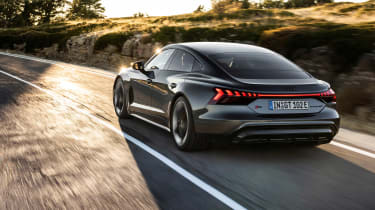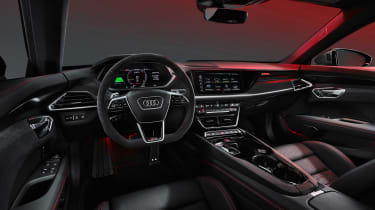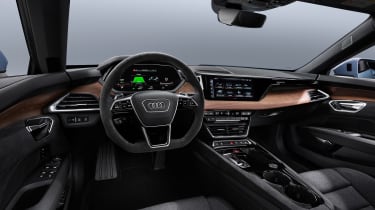Audi RS e-tron GT revealed – high-performance EV to rival Porsche Taycan and Tesla Model S
Audi’s new electric car borrows more than a little from the Porsche Taycan, but offers its own distinctive style
This is the long-awaited Audi e-tron GT quattro. Sharing more than a little of its technology, style and philosophy with the Porsche’s Taycan, the e-tron GT is not just Audi’s first bespoke electric vehicle, but an example of the expanding synergy between the two brands. Revealed in both ‘standard’ e-tron GT Quattro, and high performance RS e-tron GT forms, the new electric car represents just the beginning of the brand’s onslaught of new EVs, giving us an early look at what Audis of the future might become.
The e-tron GT was initially revealed as a concept at the 2018 Los Angeles motor show, which ignoring a few concept car embellishments, has turned out to be faithful to the production car. Its low-slung and aggressive stance is also similar to the Taycan, which shares the same J1 platform, motors and battery pack.
Powertrains and range
Both Audi e-tron GT variants are powered by two permanently excited electric motors, one on each axle. The rear axle is driven through a two-speed transmission, as in the Porsche, with the front motor only having the one ratio. Peak power is rated at 469bhp for the e-tron GT quattro, with an overboost function unlocking an extra 53bhp and taking the total to 522bhp. Peak torque is rated at 465lb ft, which gives the GT figures between a Taycan 4S with and without the performance battery option. The RS e-tron GT has a higher 589bhp output with a 636bhp overboost peak, while torque is a more muscular 612lb ft – all higher than the Taycan Turbo, but a fair way off the Turbo S.
While the Audi’s hardware might sound similar to the Taycan’s, the difference lies in how one accesses those overboost figures. In the Porsche, overboost figures only apply during the launch control function, but the Audi’s overboost functions can be accessed when full-throttle is applied in the e-tron GT’s dynamic mode, as well as in its launch mode for shorter 2.5sec bursts.
Without the headline-grabbing peak outputs of the Porsche, it’s not surprising to see the acceleration numbers down, but the standard e-tron GT and RS e-tron GT still reach 62mph in 4.1sec and 3.3sec, respectively. For reference, the Taycan Turbo and Turbo S will do the same sprints in 3.2sec and 2.8sec. The top speed in all is limited to 155mph.
The Porsche and Audi also share the same battery pack, with a gross capacity of 93kWh – 85kWh net. The battery cells also sit within the same layout between both axles, with a cut-out in front of the rear seats to increase foot space. The 800V electrical system is shared, so too the 270kW DC charging capability. The Audi does offer marginally superior WLTP range claims though, with a 303-mile range projected for the e-tron GT quattro, and the RS only a few less at 293 miles – the 4S and Turbo are rated at 288 and 286 miles.
Chassis, interior and design
The suspension is of a double-wishbone design at all four corners, with basic e-tron GT quattro models riding on steel springs and adaptive dampers with a locking rear differential and steel brakes. RS models upgrade to three-chamber air-springs, an electronically controlled locking rear differential and larger tungsten carbide-coated brake discs, but standard GTs can be specified with air springs and the electric locker from the options list. Both can also be optioned with all-wheel steering and full-house carbon ceramic brakes.
The interior is unique to the e-tron GT. Designers have attempted to accentuate the sense of space, creating a horizontal divide by segmenting the dash with a large slab of trim that varies in finish depending on the model. Much of the switchgear and interior tech is borrowed from other Audis, with a familiar MMI touch interface angled towards the driver and a set of physical keys controlling heating and ventilation below.
The exterior design is even more distinctive of other Audi models though, with design chief Marc Lichte introducing the first application of its inverted grille design, which places a body-coloured panel where the single-frame Audi grille would traditionally sit, wrapped in a black ‘mask’ that integrates with the ornate headlights. To reinforce the presence of the e-tron GT’s electric powertrain, the bonnet has a very obvious scallop moulded out from its surfacing – a playful contrast to the usual bonnet bulge that features in many performance Audis.
The silhouette is also a departure for the Audi brand, with a fastback roofline and rear deck that references neither the traditional Audi three-box or Sportbacks shapes. Instead, as with all Lichte designs, the wheel arches are the main focus, with each defined by expressive double-facet lines above, that Audi says reference the boxy arches of iconic models like the Quattro, but in a new form.
Pricing
The e-tron GT represents a big jump for the brand, and like the Taycan has for Porsche, signals a new, more multi-faceted approach to attracting customers for a high performance vehicle. Yet while all might seem worryingly familiar to the Porsche Taycan, there is one key difference.
Final UK prices have yet to be announced, but in overseas markets the e-tron GT is significantly less expensive than the Porsche Taycan, priced at €99,800 (£87,457) for the base car and €138,200 (£121,223) for the RS. For reference, a Taycan 4S with the large battery pack starts at €112,008 (£98,256) before options, and a Turbo S is a whopping €186,336 (£163,459). These price points should translate into a decent saving when it arrives in the UK later in 2021, but whether the e-tron GT can keep pace with the Taycan on the road is a question we look forward to answering.











